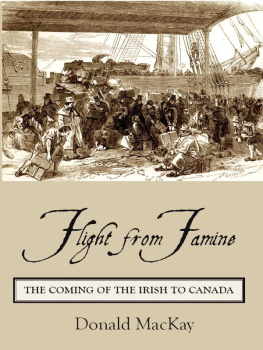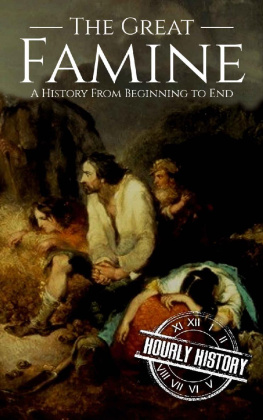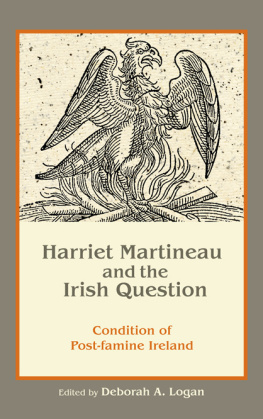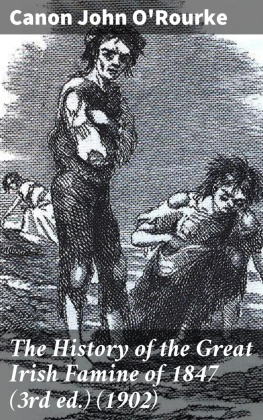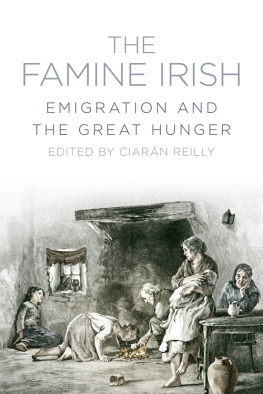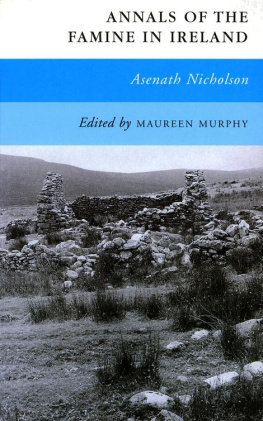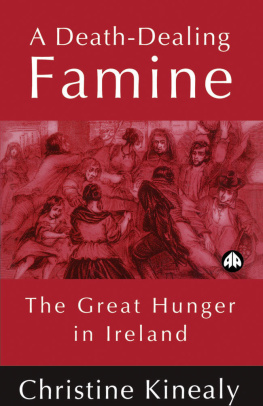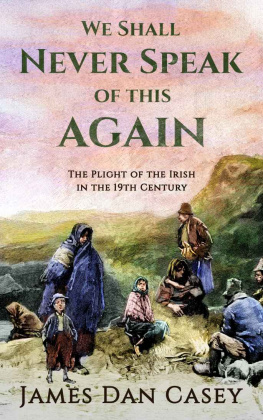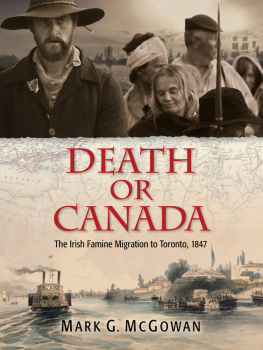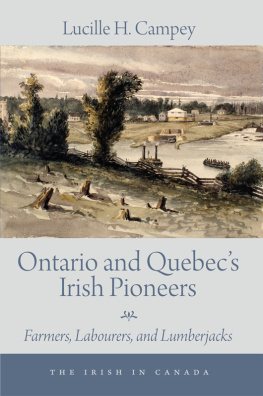
Flight from Famine
Also by Donald MacKay
The Lumberjacks
Anticosti: The Untamed Island
Scotland Farewell: The People of the Hector
Empire of Wood: The MacMillan Bloedel Story
Heritage Lost: The Crisis in Canada's Forests
The Asian Dream: The Pacific Rim and Canada's National Railway
The Square Mile: Merchant Princes of Montreal
The People's Railway: A History of Canadian National
Train Country: An Illustrated History of Canadian National Railways
(with Lorne Perry)
Flight from Famine
THE COMING OF THE IRISH TO CANADA
Donald MacKay

Copyright Donald MacKay, 2009
Originally published by McClelland & Stewart in 1990.
All rights reserved. No part of this publication may be reproduced, stored in a retrieval system, or transmitted in any form or by any means, electronic, mechanical, photocopying, recording, or otherwise (except for brief passages for purposes of review) without the prior permission of Dundurn Press. Permission to photocopy should be requested from Access Copyright.
Edited by Michael Carroll
Copy-edited by Jason Karp
Designed by Erin Mallory
Printed and bound in Canada by Marquis
Library and Archives Canada Cataloguing in Publication
MacKay, Donald, 1925
Flight from famine : the coming of the Irish to Canada / written by
Donald MacKay.
Includes bibliographical references and index.
ISBN 978-1-55488-418-6
1. Irish--Canada--History--19th century. 2. Immigrants--Canada--History
19th century. 3. Ireland--Emigration and immigration--History--19th century.
4. Canada--Emigration and immigration--History--19th century. I. Title.
FC106.I6M33 2009 971'.0049162 C2009-900011-3
1 2 3 4 5 13 12 11 10 09

We acknowledge the support of the Canada Council for the Arts and the Ontario Arts Council for our publishing program. We also acknowledge the financial support of the Government of Canada through the Book Publishing Industry Development Program and The Association for the Export of Canadian Books, and the Government of Ontario through the Ontario Book Publishers Tax Credit program, and the Ontario Media Development Corporation.
Care has been taken to trace the ownership of copyright material used in this book. The author and the publisher welcome any information enabling them to rectify any references or credits in subsequent editions.
J. Kirk Howard, President
www.dundurn.com
Published by Natural Heritage Books
A Member of The Dundurn Group
Front cover illustration: A large number of Irish sailed from Liverpool, the busiest emigration port in the United Kingdom. At the heart of the miles of waterfront was Waterloo Dock, whose turmoil was depicted in the Illustrated London News, July 6, 1850. Courtesy of the Toronto Public Library.
Back cover photo: Ireland Park with the Toronto skyline in the background. Courtesy of the Ireland Park Foundation, Toronto.
For Barbara Elizabeth, with love
CONTENTS
A s with most books, many people contributed in one way or another to the progress of this volume. Doug Gibson of McClelland and Stewart, Professor Carl Berger of the History Department, University of Toronto, and James M. Whalen of Library and Archives Canada, Ottawa, all helped get it started, and in addition Jim Whalen contributed his extensive files on Irish immigration to New Brunswick and read the manuscript, as did Professor Hereward Senior of the History Department, McGill University.
I am grateful to the Canada Council and the writing and research program of the Multiculturalism Directorate of the Secretary of State for grants without which the book could not have been attempted.
I am indebted to the Irish Texts Society and the Mercier Press of Cork for permission to quote from the translations of Humphrey O'Sullivan's diaries; to Marianna O'Gallagher of Ste-Foy, Quebec, whose many years researching the tragic past of Grosse Isle brought its story back to life after half a century of oblivion, for her encouragement, as well as assistance in locating a photo of Dr. George M. Douglas; to Mr. Clare Galvin of Ennismore, Ontario; to Mrs. Mary Gallagher of Cambridge, Ontario, and Olive Doran of Peterborough, Ontario, for photos of their ancestors, who were emigrants in the Peter Robinson migration.
I must also thank the staff of Library and Archives Canada, Ottawa; the National Library of Ireland, Dublin; the Oral History section of University College, Dublin; the Cork County Archives, Cork City Library; the University of Cork, the New Brunswick Museum, Saint John; the Archives of Ontario, Toronto; and the City of Toronto Reference Library.
The seminal genealogical work of Carol Bennett of Renfrew, Ontario, whose work is available in Peter Robinson's Settlers, was invaluable in studying the families who arrived with Robinson in the early 1820s and I am grateful for the further advice she provided.
In Ireland, my friends Lee Snodgrasse and Paddy O'Leary of Ballydehob, Mary and Dennis Barrett of Cork City, and Jill Cunningham and Kevin O'Mahony of Durrus were all splendid guides to the secrets of west Cork. In Ottawa my work at Library and Archives Canada was rendered the more pleasant by the hospitality of Penny and Clyde Sanger. I would also like to thank Hilary Chick of Scarborough for keying in the final draft. Having thanked all these kind people, I hasten to add that errors and shortcomings are my own.
I was fortunate, as with four books in the past, in my editor, Robin Brass, without whose painstaking labour the result would have been less than it is. Robin has raised editing to the art of collaboration.
T he Irish came early to Canada. By the 17th century, they were putting down roots in the fisheries of Newfoundland. In the 18th century, soldiers of the Irish Brigade serving in the French army were celebrating St. Patrick's Day in Quebec City. Among the founders of Halifax in 1760 the Irish made up a third of the population, and in New Brunswick there was much talk of naming the province New Ireland.
After the end of the Napoleonic wars in 1815, the number of Irish in British North America increased dramatically. Two of every three were Protestants, mostly transplanted Scots Presbyterians from Ulster. Like the Empire Loyalists, they were among the early settlers of Upper Canada, establishing farms or working on the canals or in the timber trade. During the Great Famine of 1845-50, the ratio abruptly changed, however, and the majority were impoverished rural Catholics from the Gaelic west who were forced to flee their homes to avoid starvation and death.
Despite an early history of famines, tribal wars and invasions by Vikings and Anglo-Normans, the annals of 16th-century Ireland suggest a self-contained island of a million people with enough food for all. That pastoral world, whose poets sang of "the Golden Vale of Munster," was shattered forever on Christmas Eve 1601 when an English army, which had subdued most of the country with fire and sword, defeated the last of the great Ulster chieftains in an effort to anglicize the island once and for all. Early in that tumultuous century, Oliver Cromwell's brutal invasion combined with famine and plague to kill a third of the population. At the end of the century the English victory at the Battle of the Boyne, relived in our own times in the streets of Ulster and the Orange parades in Canada, caused a Gaelic poet to write despairingly of the 17th century as "the evening and the end of the day."
Next page
